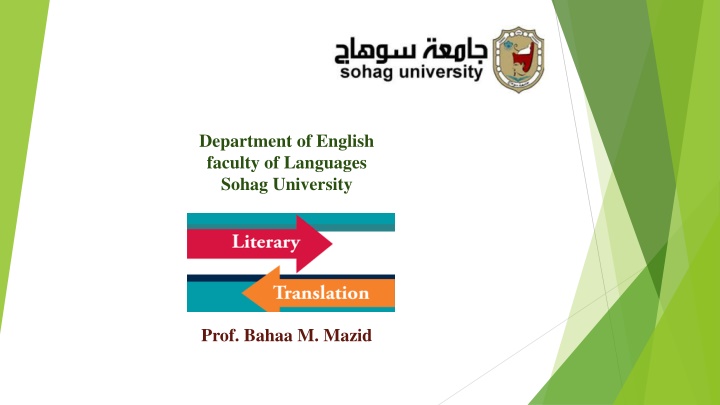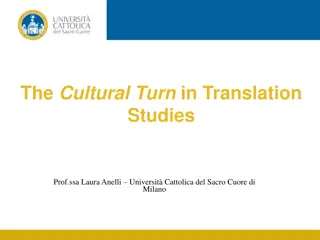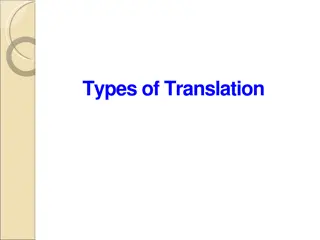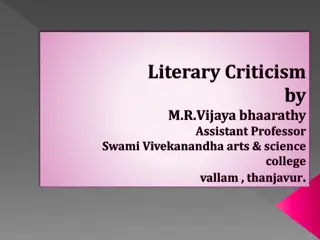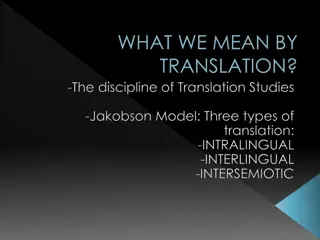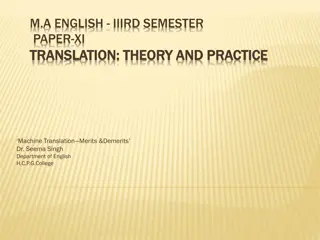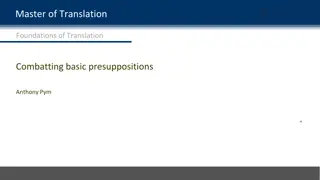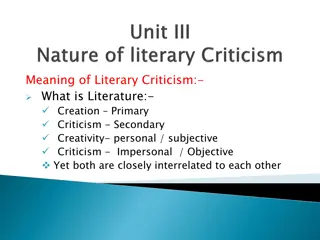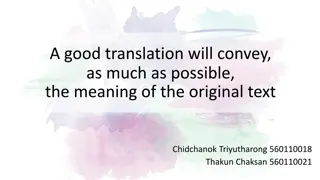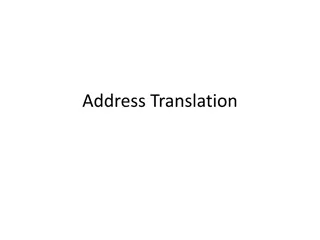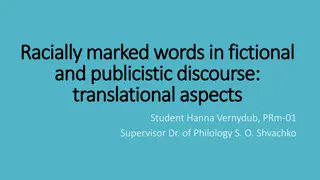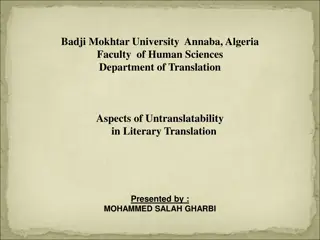Essentials of Literary Translation: Understanding the Art and Skill of Interpreting
The process of literary translation involves creativity, cultural understanding, and maintaining the essence of the original text. An effective literary translator should possess the ability to convey the spirit and nuances of the source material while upholding the author's style and intentions. Avoiding omissions and maintaining fidelity to the text are crucial aspects in producing a successful literary translation. Through dedication, attention to detail, and adherence to the requirements of literary translation, a translator can ensure the integrity and impact of the original work is preserved in the translated version.
Download Presentation

Please find below an Image/Link to download the presentation.
The content on the website is provided AS IS for your information and personal use only. It may not be sold, licensed, or shared on other websites without obtaining consent from the author.If you encounter any issues during the download, it is possible that the publisher has removed the file from their server.
You are allowed to download the files provided on this website for personal or commercial use, subject to the condition that they are used lawfully. All files are the property of their respective owners.
The content on the website is provided AS IS for your information and personal use only. It may not be sold, licensed, or shared on other websites without obtaining consent from the author.
E N D
Presentation Transcript
Department of English faculty of Languages Sohag University Prof. Bahaa M. Mazid
*The main task of an interpreter and procedure of translation A literary translation is truthfully a creative process. An owner of this process should feel the words and should have a skill of describing, interpreting them in the translation. If we use it only with modern language, a literary translator should have a sensor power.
The General Peculiarities of Literary Translation The translation is the reliable to Literature. It is an armor of understanding the culture of world. The development of moral-ethical of human life and a mean of contributor to the people s culture of the world. Interpreting the spirit of the work is the main task of literary translation so a reader can read fluently and feel the spirit of the original text as in his own native language in translation as well. Each literary translation should give an inspiration as to the reader as it was in origin.
There should not be omissions, transformations and addings in literary translation. The deficiency made by the author also should be translated and described in translation, so a reader can read the author s mistake, having read it can freely make his own review. If a literary translator is inexperienced and not a hardworker, he may let his fantasy and stays far from originality. Experienced and hardworking translator makes his effort in keeping the originality of the text. He does his best in revealing every things in detail. He checks his translation meanings through encyclopedic books, dictionaries and ither source of internet communications.
Bad translator makes work his excellent translator makes work authors. A literary translation is called as a result accepting the ethical and moral level of the text and the individual peculiarities of the original text are kept. A literary translation is a work that written in other language, that kept at maximum the system of personage, semantic expressions and language uniqueness. A literary translation is an approach of communication contact. It is an international, cross culture-communicative and ethnic point of view source.
Requirements of literary translation Retransfer literary work Preserve the artistry in translation 1.Adequacy of images and forms 1. Adequacy of tune (in poetic translation) 2. Compatibility of the meaning 2.Adequacy of author s style and logic 3.Maintaining a pragmatic effect
Effective means of translating literary works Translating literary works is a complicated task that is full of challenges. - It is necessary to properly research the work in question and consider the - eventual readers to achieve a good translation. To many translation companies, translating a literary work is so arduous that - they sometimes refuse the offer. However, it is not that complicated if some guidelines are followed.
Here is a brief guide that helps you with your literature translation and serves as a basis to design your own guidelines: Acquaint yourself with the task 1. Translation of literature works starts much before the first words are converted into a. another language. A proper translation procedure begins with finding out all about the literary piece. The author and his work: A research on the author s life and work can help you b. understand better what he wanted to convey with his literary pieces. Besides, writers usually draw references from other pieces in their work. One must recognize and take into account these points while translating. The message: What does the author want to convey through a certain literary work? To c. understand this deeply, it is important to study the cultural, social, and historical contexts in which it was written, because the message is often related in and around them.
2. Back Translation Noise Get familiar with the genre: You must take into account the characteristics of a. the genre. For instance, if you are translating a police novel, getting familiar with this genre s usual topics, style, and vocabulary is a good idea. b. Do not forget the target: Who are the people you are translating for? What are readers looking for while reading the literary piece? Think about their expectations and meet those with your translation.
Translating literature to other languages a. Once all the previous tasks are completed, you are ready to start your translation. It is time to focus on your tool: The language b. Adaptation: The main difficulty while translating literary works occurs when you are transmitting ideas to other cultures. Some common doubts that arise during the process are as follows: How much do the readers know about what I am translating? Are these cultural references going to be understood by them? c. Usually, translators decide how accurate they want their translations to be. Sometimes, names and expressions are preserved, whereas in other cases everything is translated to facilitate reading comprehension. This usually occurs while translating children s literature.
Translating literature to other languages (continued) d. Respect the style: Translators should follow the original work s patterns. Formal or informal, comical or serious, and dramatic or epic styles and genres should be preserved in translation e. Focus on the important fragments: Different parts of the literary piece can cause you more or less trouble while translating. Do not worry if some segments take more time than others, and keep focusing on those parts that can be more interesting for the reader. A part of your job comprises understanding how to get the most out of the translation. f. There is no doubt that literature translation is complicated and requires concentration; however, a good translation is an invitation to enjoy an adventure through literature.
This part of the lecture is devoted to analyzing the translation of two literary Arabic texts, namely two novels written by Naguib Mahfouz: AlSimman wa l-Kharif (Autumn Quail) and Afrah Al-Qubbah (Wedding Song) to find out how Arabic imperfect verbs ( ) are translated into English. The structures in which Arabic imperfect verbs occur are sorted into ten classes: 1- the bare imperfect form, 2- the construction /sa-, sawfa/ + imperfect , 3- a subjunctive particle + imperfect, 4- the construction /lam/ + imperfect , 5- the construction /kaana/ + imperfect , 6- the construction /qad/ + imperfect , 7- the construction /maa zaala/ + imperfect , 8- the construction /li-/ + imperfect , 9- a conditional particle + imperfect, and 10- the construction /la-/ + imperfect .
Translation of the Bare Imperfect Form () from Arabic to English Example 1: The translations of the Arabic bare imperfect form are in the English present simple; this is used when the imperfect form expresses an action that happens regularly or habitually. (1) a. ) 20 ( b. We inhale corruption in the very air we breathe. (Autumn 24) (2) a. ) 40 ( b. The woman never stops dreaming. (Wedding 21)
Translation of the Bare Imperfect Form () from Arabic to English Example 2: The Arabic bare imperfect form can also be used to refer to all-time truths or scientific facts. In this case, it can be called the gnomic or generic from, defined by Trask (1993, p.119) as denoting the aspectual form expressing a general or universal truth. It is also expressed in English by the present simple tense: (1) a. ) 50 ( b. Opium ruins everything. (Wedding 27) (2) a. b. Metals expand on heating.
Translation of the Bare Imperfect Form () from Arabic to English Example 3: The Arabic imperfect is translated to English present progressive when the imperfect form denotes an activity that is occurring at or around the moment of speaking: (1) a. ) 34 ( b. The Army s defying the King. (Autumn 36)
Translation of the Bare Imperfect Form () from Arabic to English Example 4: Translating the Arabic bare imperfect form is occupied by the English past simple tense when the imperfect form indicates an action that happened in the past, i.e. before the moment of speaking: (1) a. (52 ( b. His eyes gave off a queer look. (Wedding 29)
Translation of the Bare Imperfect Form () from Arabic to English Example 5: The translation of the Arabic imperfect form is occupied by the English -ing participle. This happens when the Arabic imperfect verb refers to an action that is/was continuous at the time of another action: (1) a. (6 ( b. The man yelled, moving on. (Autumn 12)
Translation of the Bare Imperfect Form () from Arabic to English Example 6: The translation of the Arabic bare imperfect form is filled with the English past progressive when the imperfect form signifies continuous actions in the past. So, the translator employs the past progressive to render Arabic imperfect verbs, as in: (1) a. (61 ( b. Hunger was knocking at the old house s door. (Wedding 32)
Translation of the Bare Imperfect Form () from Arabic to English Example 7: The Arabic bare imperfect form can be translated into English by the future simple construction, which include will or shall and the base form of the verb. This happens when the imperfect verb refers to a future action: (1) a. (32 ( b. And afterwards we ll travel directly to Europe. (Autumn 35)
Translation of the Bare Imperfect Form () from Arabic to English Example 8: The Arabic bare imperfect is also translated into English future simple when it occurs in the result clause of a conditional sentence, as in: (1) a. (21 ( b. We ll support the devil himself if he volunteers to save the ship. (Autumn 25)
Translation of the Bare Imperfect Form () from Arabic to English Example 9: The English present conditional tense, that is would/could/should + base verb , is sometimes used to translate the Arabic bare imperfect form; this translation is adopted when the imperfect form expresses a hypothetical meaning: (1) a. (45 ( b. Why would he kill Tahiya? (Wedding 23)
Translation of the Bare Imperfect Form () from Arabic to English Example 10: The Arabic imperfect form can sometimes be rendered into English by the present perfect tense; this translation is employed when the imperfect form refers to actions that began in the past and continue up to the present moment or still have their effects in the present: (1) a. (18 ( b. You ve neglected your health. (Wedding 8)
Translation of the Bare Imperfect Form () from Arabic to English Example 11: It has to be stated here that since the verb in the previous slide expresses an action that started in the past and continues to the present, it can also be translated by the English present perfect progressive: (1) c. You have been neglecting your health. In a few instances, the English construction be going to + base verb can be used in the translation of the Arabic imperfect form; this occurs when the imperfect form signifies an action that is going to happen in the near future: (1) a. (7 ( b. Are three million people going to spend the night without any shelter? (Autumn 13)
Translation of the Bare Imperfect Form () from Arabic to English Example 12: A few examples of the bare imperfect form in Autumn Quail are translated into English by the past perfect tense. This translation is adopted when the imperfect shows the completion of an action before another action or time in the past: (1) a. (23 ( b. She had been fond of Isa s mother for a long time. (Autumn 27)
Translation of the Bare Imperfect Form () from Arabic to English Example 13: The least frequent translation of the Arabic bare imperfect form is the English present progressive conditional, i.e. would/could/should + be + V + ing . This is illustrated by one example in Autumn Quail that expresses continuous future in the past: (1) a. (10 ( b. I ... wondered what this old man would be thinking. (Autumn 16)
